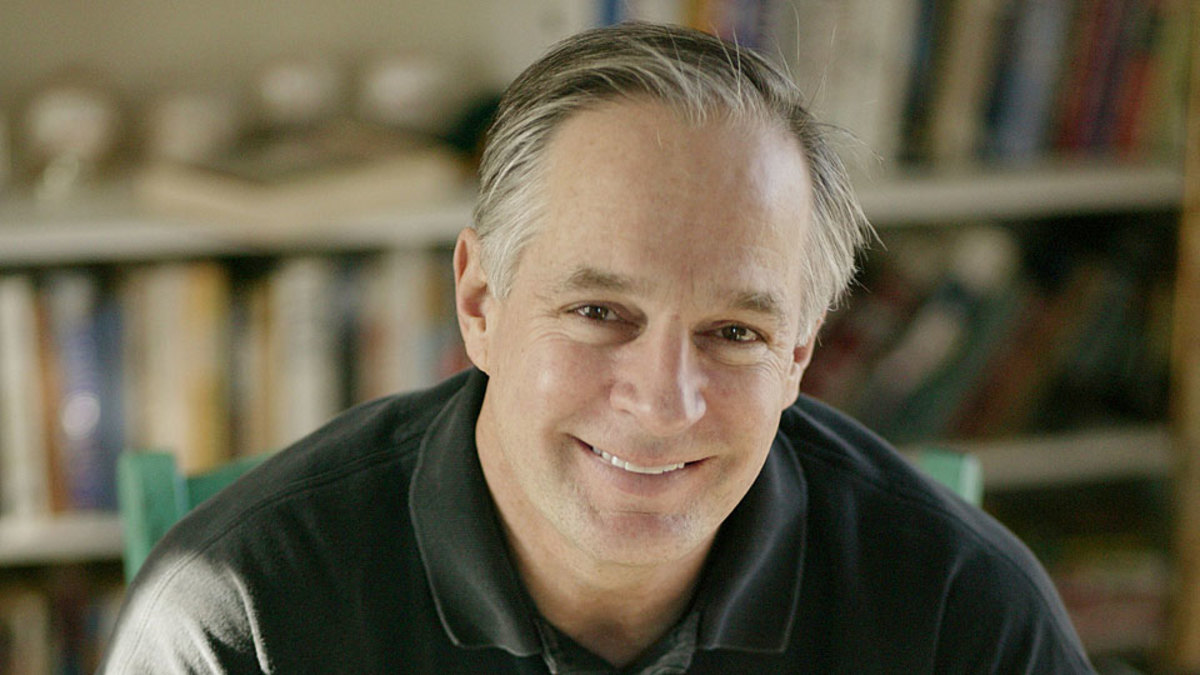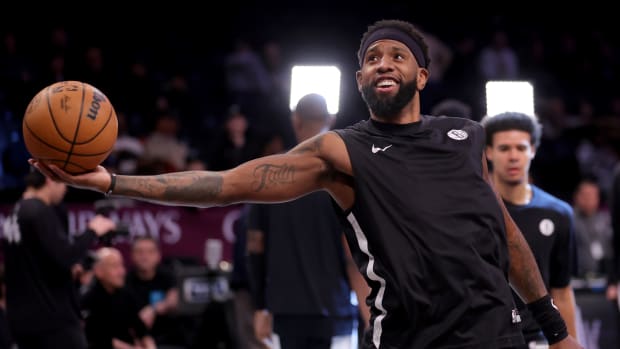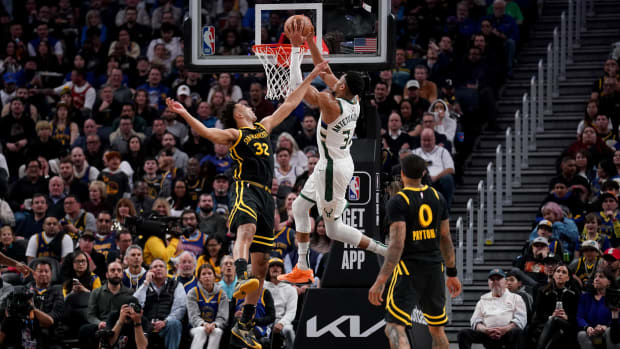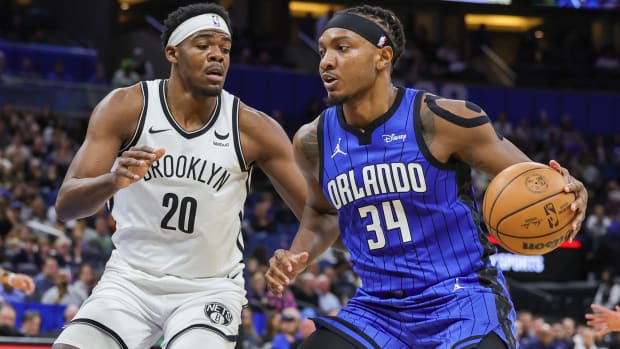SI 60 Q&A: Rick Telander on basketball heaven and writing hell
After his college football career at Northwestern ended and his professional football career failed to really begin, Rick Telander started writing stories – literally. He couldn’t type and so he wrote his early pieces in longhand. That’s how he penned his debut story for Sports Illustrated, "Football Is Like A Rose," a first-person account of being cut by the Kansas City Chiefs, who had drafted him in 1971, that was published in the summer of 1972. The title came from the description of the sport from a Florida wide receiver who said football was “nice, but isn’t essential.”
“I like that. I like that a lot,” Telander wrote. “It sums up exactly what the sport of football should be and, by contrast, is not.”
There was another sport, however, that was essential to Telander’s career and in some ways to his life. In 1973 he wrote a story for SI called “They Always Go Home Again,” about college basketball players from the New York area who returned from school to hone their skills in outdoor pickup games. It became the basis for Telander’s 1976 book, Heaven Is A Playground, which was later named one of the top 100 sports books of all time by SI.
Though he wrote largely about college football as an SI senior writer, Telander remained entranced by basketball and the variation of it he had chronicled so masterfully. Even after leaving the magazine in 1995 to become a columnist at the Chicago Sun-Times, where he remains today, he returned to the subject of pickup hoops twice for Sports Illustrated.
Asphalt Legends: Pickup basketball in New York City
The second and most recent time was in the fall of 2012 as the Brooklyn Nets prepared for their debut season in the same borough that Telander had written about in Playground.
The first had come in 1997, when he checked out the state of the summer game and found that everything from the culture to the style to the quality of play was much like it had been 20 years before. “Asphalt Legends” ran as the cover story of the Aug. 18, 1997 issue. I spoke with Telander about that piece, his love for the game and his feelings about Sports Illustrated.
SI: You were an all-Big Ten defensive back at Northwestern. What drew you to basketball?
TELANDER: I loved playing things and that was the one sport that was more enjoyable for me to play as well as watch sine I was a little kid. I played in high school and I was a varsity player but I was 6-1 and more of a power forward in a tiny little body. I just enjoyed the game, and the different sociological aspects and everything that came together in pickup basketball. There was no other sport where you could do that -- just find a group of guys somewhere and start playing. You can’t do it with baseball and you certainly can’t do it with football, which is organized beyond belief.
The game of basketball is, in my opinion, the most amazing sport ever invented because it was invented. One day it didn’t exist and the next day it did. Other games evolved into what they became. Not basketball.
SI: Where did the idea for that first playground hoops story come from?
TELANDER: I had talked with Pat Ryan, who was then the articles editor, about my fascination with basketball and city basketball in particular, and we came up with this idea of following college players when they came home to the big city in the summers, which they still did back then. It was Brian Winters, who played at South Carolina and was from Queens; John Shumate, who was from Elizabeth City, N.J., and played at Notre Dame; Dennis DuVal, who was from Westbury, on Long Island, and was the starting point guard for Syracuse; and then there was this guy, Fly Williams, right in the heart of Brooklyn. I just knew I had to find out more about this. So I came back the next summer and that’s when I wrote Heaven Is A Playground.
SI 60 Q&A with John Ed Bradley: The story behind "The Best Years Of His Life"
SI: What is it you love so much about pickup basketball?
TELANDER: It’s a game that is meant to be played inside in the winter, so seeing this offshoot of it -- outdoor street basketball -- was fascinating to me. Not only that, it was mesmerizing. And then I read The City Game by Pete Axthelm, and the parts about Harlem and the inner city of New York and the connection of those players who went to places like Marquette where they were so far away was fascinating. And the names of the guys. They all had nicknames, like Earl “The Goat” Manigault. It was like American mythology. Paul Bunyan was a country legend. These guys were urban legends. The fact that it wasn’t well documented and it was all just word of mouth made it all the more intriguing.
• SI 60: Read every story and interview in the collection
SI: Was it your idea to come back and write about city hoops again for Sports Illustrated?
TELANDER: I think it was Greg Kelly, a senior editor at the magazine, who called me up and said “Rick, city basketball is big. Let’s do it again.”
There was a documentary that had just come out called Soul in the Hole. There was a tournament called that over in Brooklyn and there were all these different characters in it and it was very much what I had found years before. Great players, great city players and they were still almost mythological. There was this one kid in it, Booger Smith, and at the start of it he says, “What I really want to get me is a Lexus.” It was this preposterous thing, but he was dreaming and he had no means to get there. He seemed like a fascinating guy. I said, “How about it I just go and try to find Booger Smith?”
SI: The story, in some ways, is a quest to find him while you also discuss the streetball scene in general. Did you originally want it to be entirely about him?
TELANDER: If I hadn’t been able to find him at all I would have felt I didn’t have a story. As I was searching for him I saw more and more and had more and more [material]. I could have had Booger just as this running theme that I could never find. En route I spent some great time with Earl Manigault, who had been through the gates of hell and was trying to give back. Going up to Rucker Park was fascinating, as was going around seeing the whole city scene all over again. That could have been enough in itself.
I was going around with the photographer, John Huet, and he needed to find Booger. You can’t photograph him if you can’t find him. When he finally did appear at Tillary Park one day I was absolutely thrilled. I saw him play and we shook hands, I told him to stick around because I wanted to do a lengthy interview with him and meanwhile I talked with other people and then he was gone. To me it was very symbolic. He just drifted back into the anonymity of this very impersonal steel city where on the court he’d put on this performance of sheer brilliance and beauty.
There’s so many things captured there. There are things you can’t control, like where you came from and the damage this world does to people and the art forms all of us have hidden inside and have this one moment to display it on the stage.
Booger did some stuff [on the court] that John couldn’t quite capture because we didn’t even know what he was doing with the ball. I tried to describe it but there was no replay so you didn’t know what you had just seen.
SI: He obviously got some good shots, because Booger made the cover. Was the plan for it to be a cover story?
TELANDER: I didn’t know, but I hoped it would be. With SI you were never certain that anything would be a cover story. First of all it had to be a compelling story and then there had to be a beautiful photo. John was taking shots one after another in black-and-white and that was back when you had to look at the film to see what he had gotten. We didn’t know he had a cover shot and he didn’t know what he had, but it had to be in focus and not be shielded, to have the sun right and zoomed in properly. That was a hell of a tough thing.
The cover itself is a work of art. I’ve got it hanging up.
SI: Do you have any idea what happened to Booger?
TELANDER: We actually became friends, and I’m friends with Fly Williams and Albert King, too. I don’t want to say I bond with them, but I don’t like to just write about them and say, “Thanks I used you, goodbye.”
Booger came to Chicago one time, this might have been around 2000, trying to capitalize a little on his brief fame, and I got some buddies together and played ball with him. We played hoops a couple times at a gym up here in the northern suburbs of Chicago and those guys still talk about playing with him. I don’t think he shot for the first 10 minutes, he just threw these passes that were astounding and beautiful. His expression never changes, and he doesn’t talk. He’s the littlest guy on the floor, skinny as a rail and he was just amazing.
SI: Fly Williams was a college star and played in the ABA. Albert King played high-major Division I basketball and played in the NBA. And in “Asphalt Legends” one of the players you mention is Smush Parker, who went on to play for the Lakers. Was Booger at the level of those playground legends?
TELANDER: You can’t coach height and Booger’s probably 5-9, 5-10. Streetball is a form of the game that is played in certain places and certain ways and there, Booger is a five-star, All-World. If you’re playing somewhere the wind is blowing, there are bumps in the floor and people are yelling at you on the sidelines, you gotta have Booger.
SI: Was it a fun story to write?
SI 60 Q&A: Curry Kirkpatrick on the artistry of Pete Maravich
TELANDER: It sure was enjoyable to research but it was somewhat painful to write because I thought, “OK, Rick people think you’re an authority on this so you better not sound ignorant.” I don’t want someone who’s lived this life to say that’s not true, that’s nonsense.
SI: How do you like the story now?
TELANDER: It’s very special for me. Like every story I ever wrote I didn’t know if people would like it, if it was stupid or if it took the wrong direction or if it was something nobody else had any interest in. The one thing I thought I’d done was capture the feel of the city in the summer in the playgrounds again.
It’s hard to read a story like that to yourself because you lose yourself in these stories. For the reader the beginning might have been 30 minutes earlier but for the writer it may have been three days earlier or five days earlier. There’s no way the path you’re taking follows a natural and enjoyable arc. You’re sick of your stories when you’re done. You put everything into it and you’re dry, you’re drained.
Rick Reilly and I used to talk about the worst sound in the world being when the shades are drawn, you’re in a hotel room somewhere and you hear the first sounds of a bird tweeting outside and then you hear the thump of USA Today against your door and you’re still sitting there locked in front of your screen. We talk about the horrors of it all because you’re using a tool, writing, to take the letters of the alphabet to comprise words that hopefully will symbolize what you see in your mind, and you don’t even know if it’s worthwhile expressing to people. When it finally comes and it’s there in font of you and you’ve agonized over one sentence for 15 minutes and reread it and reread it you just hate it. You hate every bit of it. It’s killing you but there’s nothing more in the world you want than to get it right. And you can’t get it right. You’re translating from your own thoughts to an imperfect form of communication.
And then you have to go back and look at you notes and you hope you have the raw material to build this structure. How long was this story?
SI: A little over 6,000 words.
TELANDER: That’s a tenth of a book. Gary Smith would say in the course of a year you write a book. We talk about these things like they’re acts of misery, but it’s all we wanted to do. There was never a story that was so important it couldn’t be killed. When that happens it just demolishes you. It destroys you. That’s why nobody knows they’re writing a cover story. Suppose there’s an earthquake at the World Series or a bombing at the Olympics and you have a story about [U.S. swimmer] Amy Van Dyken and they’d say, “Sorry.”
A Hero For The Wired World: Michael Jordan reaches new heights
I still think of SI first. It was everything to me and it still is. I could not be prouder to have worked there. There were editors like Peter Carry, Rob Fleder, all the writers -- Alex Wolff, Jack McCallum, Rick Reilly -- these are all my personal friends, Austin Murphy is still a good friend, Roy Blount was a pal from way back in the day, Frank Deford and John Papanek were friends of mine too. Editors like Greg Kelly, Sandy Padwe, go down the whole masthead. They were the best in the business. Sports Illustrated was the pinnacle of everything that had to do with sports journalism.
That’s been my life. I guess that’s why the book and the magazine piece and the editors and my whole career at SI are inextricably woven. You start to look back on things and say, “Yeah, man, that was my life.” And it was. We’re talking over 40 years. Thank God for Sports Illustrated being around. The first story I wrote for them was on spec, and it was about being cut from the Chiefs. If they hadn’t accepted that story and if they -- Pat Ryan, Ray Cave, Roy Terrell, the other editors – hadn’t been accepting of me, my whole life would be different. I don’t know what I’d be doing. I needed some encouragement, I needed something and SI was all I ever wanted to do. That was my goal. I never told anybody that but it was.
SI: Why did you leave the magazine then?
TELANDER: By 1995, I had been there 23 years and I had written 250-300 or so stories and close to three dozen cover stories. I’d never even dreamed of writing for a newspaper but writing a column in what was essentially my hometown seemed like a really interesting challenge. For the first time ever newspapers were throwing huge money around, and it was kind of like the Wild West for a few years before the Internet changed everything.
Then there was also this agreement where [former SI managing editor] Mark Mulvoy told me if I didn’t like it after six months or a year I could come back to the magazine. And I worked that out with the newspaper.
I was ready to do shorter things. I’d been writing a number of Point Afters and those were 800 words, so that was my training for writing a column and I was old enough to start doing more commentary. Plus, my kids were getting older and I wanted to be around more to watch them play sports. It was not for any lack of any love for the magazine and I always had the tacit agreement that I could continue writing for the magazine.

Rick Telander spent months reporting and writing Heaven Is A Playground, his seminal book about summer basketball.
Courtesy of Rick Telander
SI: And you did, writing several notable features since leaving. Your most recent piece for SI went right back to your roots, about the arrival of the Nets in Brooklyn.
TELANDER: If I polled guys back in the Heaven Is A Playground days about whether there would ever be an NBA team that played at that old Atlantic Avenue subway stop they would have just keeled over and died.
For that piece, I talked to [former SI managing editor] Terry McDonell more than a year in advance and I said, “They’re right there in Brooklyn at the Atlantic stop. If this doesn’t harken back to Heaven Is A Playground I don’t know what does. If you’re going to do a story on it would you consider me?” He said, “Yeah it seems like a good fit.” [Senior editor Mark] Bechtel was really helpful on that too.
SI: Do you think you’ll want to revisit this world of playground basketball again?
TELANDER: I don’t want to redo the same story again, but each time I’ve done it there’s been a twist. So to document basketball I may do Heaven Is A Playground in China someday. Maybe it’s not a city, maybe it’s some province or it may be in Africa some place, like Nigeria or Kenya.
This isn’t the NFL or NBA or MLB, this is something that’s more abstract. At its root it’s nothing but sport. It’s the beauty of play. And it captured the whole reason I did Heaven Is A Playground. This is as close to heaven as some of us will get on this earth.




































